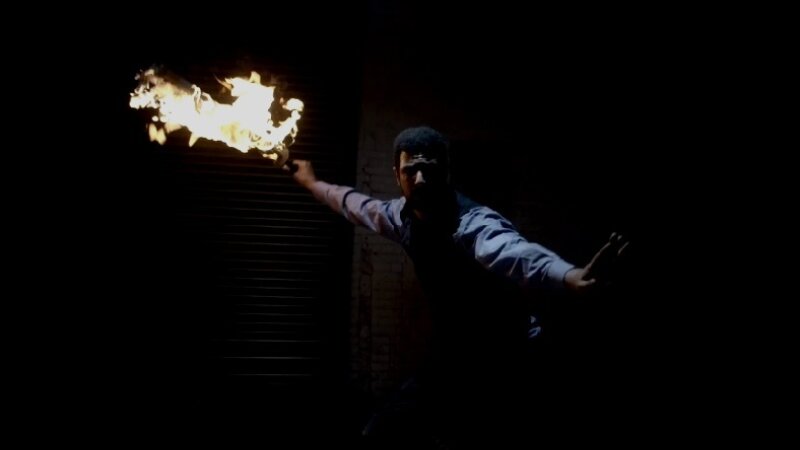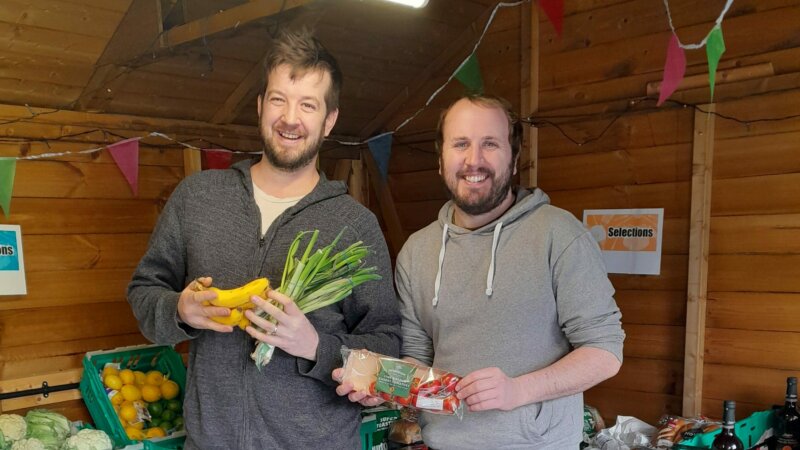Year of Making: Makers and Doers
10-18 June, Bloc Projects
sheffieldfringe.com
Running in parallel to the super-slick Doc/Fest, Bloc Projects have held their own exposition of weirder and wilder filmmaking for five years now, free brownies for attendees included. The fringe has a wider remit than its bigger sister, with most films in the programme blurring the lines between fiction, art film and straight-up documentary.
Take, for example, Tapes From The Revolutionary by Scott Willis, an attempt to profile an eccentric elderly leftist known for wandering Edinburgh with a camcorder. Perhaps inevitably, the self-declared communist attempts to take over Scott's film for his own purposes, refusing to co-operate unless his dry lectures on the bourgeoisie are filmed verbatim. Eventually the film’s focus becomes the process of its own creation, rather than the character of Andy, and he and Scott's on-screen argument as to what direction the project should take calls into question conventional ideas about authorship in art, although, as Willis pointed out in a Q&A, he had the upper hand in the edit suite.
Walk With A Cart Through Upperthorpe (pictured above, and available at vimeo.com/159962181) by Bloc resident Ian Nesbitt charts the turbulent history of one of Sheffield’s most deprived neighbourhoods through interviews with a diverse set of residents, from a recently-arrived Burmese family to 99-year-old Dotty, who blames the area’s commercial decline on government inaction.
Other films were less than five minutes, like Andrée-Anne Roussel's Chestnut Cookies. This short featured a single panoramic shot from a Mount Moiwa cable car above the Japanese city of Sapporo, over which a young woman talked about her late sister and the cookies she used to make. The contrast between the skyscraper-strewn metropolis stretching beyond the horizon and a quiet story of grief was a simple effect but a highly poignant one. Using a similar approach, but for humorous reasons, was Michael Day’s Little Things, all two minutes of which showed a passenger seat view of a jaw-dropping Norwegian mountain range, over which the car’s occupants talked about the banal intricacies of an insurance policy, seemingly unconcerned with their extraordinary surroundings.
Also set in Japan, Jagata by Daniel Jacoby told a strange little tale about a Hokkaido man who has chosen to reject public life – one of the country’s infamous hikikomori – to form a bond with a potato. Whether this bond was romantic, sexual or merely platonic remained unclear, and the man was never seen, his story told through a series of letters read by an unknown narrator. The accompanying images of monorails running backward and labourers constructing greenhouses left us in the dark as to whether ‘Jagata’ really exists, and how Jacoby sourced the letters.
Sam Gregory
Photo by Laura Page Photography
|Moore Street Substation
It’s been an ambition of mine to have a look inside the Moore Street substation for several years. I’d once seen a single image of an enormous room being used years ago for a performance and heard that it was usually out of bounds. The impression stayed with me of something in the city centre so incredible but inaccessible. Art Sheffield were lucky enough to secure the substation this year as one of the exhibition venues for their biannual festival featuring international visual artists.
Sheffield likes to use unusual spaces for art. I’ve been to shows in disused public toilets, abandoned pubs and in lots of the old, cold factory spaces now inhabited by artists. Moore Street substation, though, is something different. For fans of brutalist architecture, it’s one of the greatest buildings in the city. The vast, bunker-like structure with no windows and acres of concrete can feel imposingly cold, but go inside and the effect of the narrow stairwells running up to the top floor is surprisingly comforting and earthy, an effect heightened by the imprints of wood grain left on the smooth concrete walls.
The hall itself is one of the most astonishing spaces in our city. It’s a vast, completely empty concrete shell, extra capacity space for producing electricity that was never required. The only times spaces of this size are usually encountered are in religious contexts. Some of that reverence is in the darkness with you as you enter.
For Art Sheffield, artist Steven Claydon presented an installation called Infra-idol Assembly. This drew on footage from IBM’s research programme in manipulating the location of individual atoms. At the far end of the hall is a large visual piece, a roughly human figure comprised of atoms. It is primitive and totemic and occasionally blinks at the viewer, whilst the air is filled with sounds derived from experiments with the movement of atoms. It is powerful and ethereal and never really explains itself.
Claydon talks of how he seeks to avoid explicit authorship in his work, preferring to create environments in which things can shape themselves, free of some of their usual constraints. The space itself is essential to the effect here. In this concrete cavern, the sense of awe that sometimes hides in science is given the space it needs to be felt.
The substation was only available for Art Sheffield due to maintenance work closing some sections of the building and making it safe to enter. I gather it will be several years before it can again be accessed by the public. In the meantime, it is hanging above the ring road, the sounds of atoms still bouncing around inside.
Andy Brown
Photo by Andy Brown
|The Living Archive was commissioned for Year of Making 2016 and designed in collaboration with local design studio Dust. Having spotted a few posts about this exhibition on social media, I thought I would drop in and have a look at what was on offer, because it sounded totally different to any other photography exhibition I had heard of in Sheffield.
The exhibition as a whole was really diverse, with a wide range of photographers and subjects covered, from drag queens and travellers to wrestlers and spring makers. It was part of a larger continuing project by local collective Archive Sheffield to produce a small series of free newspapers, focussing on documentary photography through portrait images of people within the city, and screenings of films created by the group.
The interesting thing about the exhibition, and all of Archive Sheffield's work, is how it is ongoing, and will become part of Sheffield's history within the Sheffield Archives and Local Studies collections, accessible for everyone to see for generations to come.
As a Sheffielder born and bred, I was really interested in what had been produced. I found myself drawn into looking at the people captured in the images and taking time to consider their place in the city.
The images I found myself most drawn to were Clive Eggington's collection, The Site, which depicts life on a local traveller site. I love the way Clive captured the site during the winter, adding to the feeling of being outcast, the people there living an isolated life in dilapidated caravans. In particular, I really enjoyed the images showing a couple of children, one using an old pram frame as a DIY go-kart, the other sitting between two rows of caravans while a duvet cover dried on a makeshift clothes line in the background.
The other set I really liked was India Hobson's The Beekeeper, which captures Jon, a local beekeeper, at work tending to his hives, which are scattered around the city. Shown only in his bee keeper's suit, Jon's face is never revealed, and I love the way the set mixes standard portraits of him with close-ups of his hands as he pulls the honey super from the hive.
As a photographer working in the city, I was incredibly impressed with The Living Archive exhibition and will be looking out for more from Archive Sheffield in future. A huge 'well done' to the people behind the project, because it's something which, in time, the city will be proud of.
Chard Remains Photographical
facebook.com/chardremainsphotographical
Photo by Nathan Gibson
|3 June, Hope Works
hope-works.co.uk
As evening fell on Sheffield's Day of Music, which saw performances from Maxine Peake and the Eccentronic Research Council, as well as Jarvis's voice hijacking the trams, all roads led to Hope Works for a celebratory knees-up from dusk till dawn.
This was a party to mark the city's Year of Making, a 365-day celebration of the city's artists and manufacturers. But it wasn't just a chance for people to let their hair down, as the night also showcased specially-commissioned video art, synchronised with DJ sets from a smorgasbord of Sheffield's best selectors and a live set from techno royalty The Black Dog.
As midnight approached, the Little Mesters room was whipped up to fever pitch with anthemic tracks by Four Tet and Daphni, while a screen in the courtyard showed films inspired by abstract natural patterns. With the mammoth main room finally open, more video art was projected onto huge screens surrounding the decks, designed to resemble the drop hammers and pouring ladles of the steelmaking industry.
In one film, microbial life-forms seemed to crawl all over the venue, while Rob Lee's work showed waves of colour jumping in time with the kick drum. Another macabre projection saw falling eyeballs pile up on the screen like a jar of gobstoppers. Back in the rave cave, we had exhilarating chiptune played on a Gameboy by HarleyLikesMusic, followed by what was, as far as I could tell, a solo drum machine set.
Throughout the night, Hope Works boss Liam O'Shea could be spotted all over the venue, playing his own peak-time set, lending the bar staff a hand and giving interviews about the project. One kid even had a replica football shirt with 'LO SHEA' on the back, a testament to what the producer has done for dance music and the creative arts in Sheffield. Since taking over the WWI gun-barrel factory in 2012, Liam and fellow resident Chris Duckenfield have transformed the space into one of the city's creative hubs, not just for music but also for the visual arts, with its warehouse walls playing host to murals by Jim McElvaney and J Davies.
As Duckenfield treated the main room to Floating Points’ 'Nuits Sonores', images of Park Hill, the modernist icon of 1950s Sheffield, were beamed out to the crowd, creating a link between the city’s great designers of the past and those of the present, the latter looking towards the future.
Sam Gregory
Photo by Alex Morgan, Neuron Pro Audio
)




